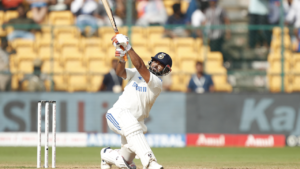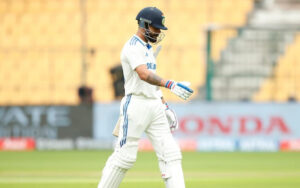
RevSportz Comment
You can always tell when the batting torch has been passed on from the reaction of the crowd. And even as wickets kept tumbling on the third morning at the Wankhede Stadium in Mumbai, the buzz in the stands refused to die down. That was because Rishabh Pant was out there for most of the session, doing scarcely believable things like reverse-sweeping out of the rough. India were never favourites to win, especially after slumping to 29-5, but Pant’s presence at the crease gave the assembled throng hope. It was only when he was controversially ruled out that the energy levels deflated.
For the last half-decade, Pant has been India’s best Test batter, averaging 44.06 from 27 Tests, even though he missed a year-and-a-half after the horrendous car crash in late 2022. He has centuries in England and South Africa and the average goes up to 51.58 in home conditions, even though India have played many of those games on bowler-friendly surfaces.
It’s also a mark of Pant’s stunning impact in the red-ball format that those runs have come at a strike-rate of 91, far quicker than what the likes of Virender Sehwag and Adam Gilchrist managed over their careers.
Once, it was Virat Kohli that inspired such hope and anticipation. After more than two decades of being in thrall to Sachin Tendulkar, India had found a batter who was even more remorselessly consistent. When he returned from a dismal tour of England in 2014 – 134 runs in 10 innings – Kohli spent days in Mumbai with Tendulkar, making subtle tweaks to his game. At the time, he averaged less than 40 in Tests.
For the Latest Sports News: Click Here

From there, starting with the tour of Australia later in the year, Kohli enjoyed a five-year period that most players wouldn’t even dare dream of. Across 55 Tests, he averaged an incredible 63.65 while smashing 21 centuries. The strike-rate of 61 hinted at how he dominated the opposition on all surfaces.
In India, that mastery was even more noticeable. Over 26 home Tests in that period, Kohli averaged a staggering 77.11 with 10 hundreds. Once he got set, he very rarely walked back to the pavilion without a match-defining knock. Between November 2014 and his 27th Test century against Bangladesh five years later, Kohli batted more than 200 balls in 15 innings. Another eight knocks spanned more than 150 balls. And as many as 19 of those were centuries.
That was then. Since December 2019, Kohli’s Test form hasn’t just declined. It’s fallen off a cliff. He averages 31.68 from 24 Tests, and the strike-rate is below 50. His average from 16 Tests in India is 29.92. And his only overseas hundred – the other was on an Ahmedabad featherbed – came in Port of Spain, which has typically had a pitch where batters book in for bed, breakfast and a buffet.
Nothing illustrates Kohli’s travails quite like the loss of focus. The man who was once the epitome of lambe race ka ghoda [long-distance thoroughbred] now struggles to bat even a session. In the last five years, only three Kohli innings have lasted more than 200 balls. There have been two others that spanned 150 or more deliveries.

If you want a comparison, consider Joe Root, who Kohli had left far behind in his slipstream as he dominated the batting charts until 2019. Since then, Root has scored 19 hundreds, with seven of them lasting longer than 300 balls. Talk of him perhaps surpassing Tendulkar’s aggregate record refuses to go away. As for Kohli, such discussions became redundant long ago.
With his career average having dropped below 48 – it peaked at 55.10 in 2019 – the only question on the eve of Kohli turning 36 is whether he can enjoy the kind of Indian summer that Tendulkar, his hero, did between 2009 and 2011. The good omen is that India’s next red-ball assignment is in Australia, where Kohli has six Test tons from just 13 matches. Only Sir Jack Hobbs and Wally Hammond, who played far more games, have more among visiting batters.
Now, though, anticipation has given way to anxiety. It’s Pant with his Catherine-wheel strokeplay who makes the punters dream. Kohli, most days, just has them thinking wistfully of a time when their hero could do no wrong.
Also Read: Strategic blunders hurt India more than on-field errors



